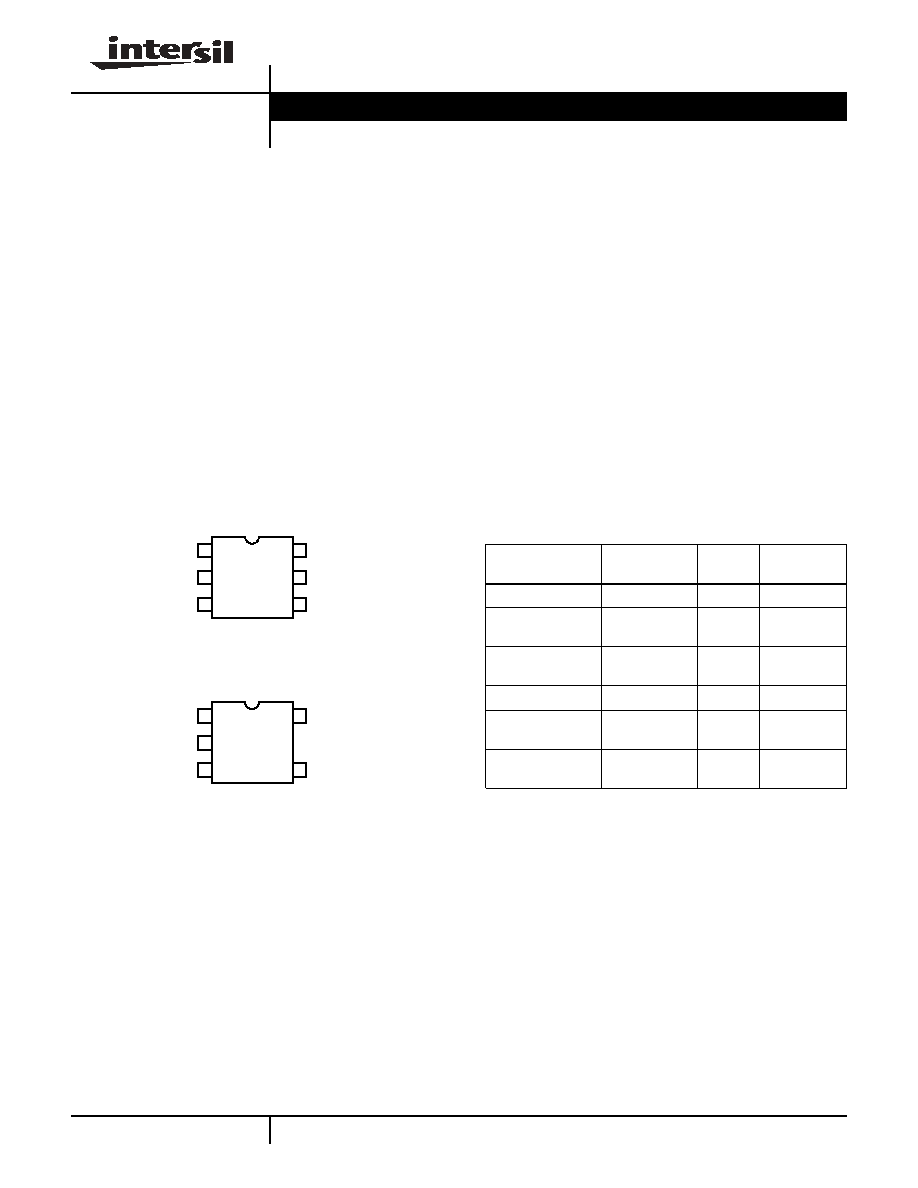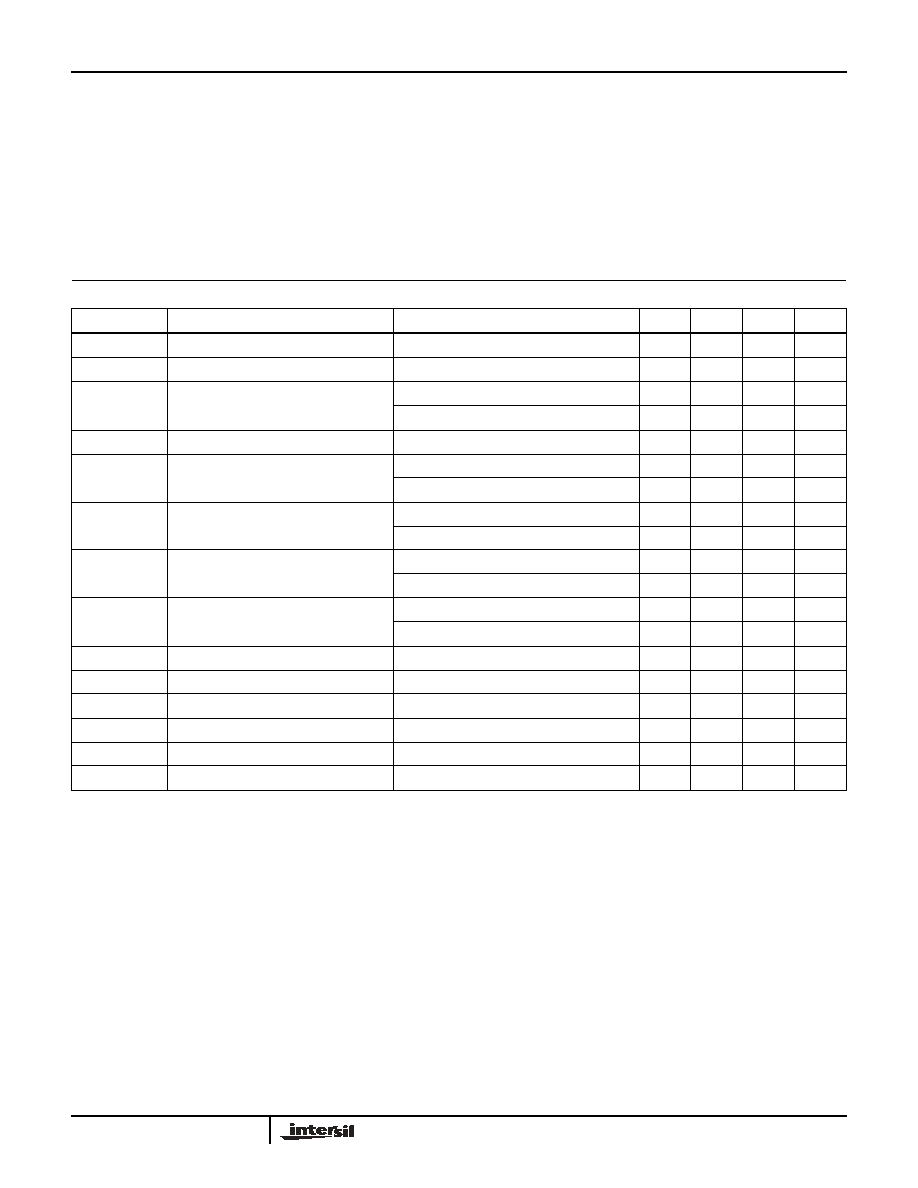Äîêóìåíòàöèÿ è îïèñàíèÿ www.docs.chipfind.ru

1
®
FN7371.0
EL7630
White LED Boost Regulator
The EL7630 represents a high efficiency, constant frequency
PWM regulator for use in white LED driving applications.
With efficiencies up to 86%, the EL7630 operates at 1.35MHz
switching frequency while operating from an input voltage of
between 2.7V and 5.5V. The maximum output voltage of 27V
enables the EL7630 to drive up to 6 LEDs in series. It is also
possible to use the EL7630 to drive LEDs in series/parallel
combination for applications requiring up to 15 LEDs.
Available in the 6-pin SC-70 and the 5-pin TSOT packages,
the EL7630 features the same pinout as competitive
products but offers higher efficiency, constant frequency
operation. It is specified for operation over the -40°C to
+85°C ambient temperature range.
Pinouts
EL7630
(6-PIN SC-70)
TOP VIEW
EL7630
(5-PIN TSOT)
TOP VIEW
Features
· Up to 6 LEDs in series
· 27V maximum output
· 2.7V to 5.5V input
· Up to 86% efficient
· 1.35MHz constant frequency
· Enable/PWM dimming control
· Pb-Free plus anneal available (RoHS compliant)
Applications
· LED backlighting
· Cell phones
· PDAs
· Handheld devices
1
2
3
6
4
LX
GND
FB
VIN
ENAB
5 PGND
1
2
3
5
4
LX
GND
FB
VIN
ENAB
Ordering Information
PART NUMBER
(See Note)
PACKAGE
(Pb-free)
TAPE &
REEL
PKG. DWG. #
EL7630ICZ
6-Pin SC-70
-
P6.049
EL7630ICZ-T7
6-Pin SC-70
7"
(3K pcs)
P6.049
EL7630ICZ-T7A
6-Pin SC-70
7"
(250 pcs)
P6.049
EL7630IWTZ
5-Pin TSOT
-
MDP0049
EL7630IWTZ-T7
5-Pin TSOT
7"
(3K pcs)
MDP0049
EL7630IWTZ-T7A
5-Pin TSOT
7"
(250 pcs)
MDP0049
NOTE: Intersil Pb-free plus anneal products employ special Pb-free
material sets; molding compounds/die attach materials and 100%
matte tin plate termination finish, which are RoHS compliant and
compatible with both SnPb and Pb-free soldering operations. Intersil
Pb-free products are MSL classified at Pb-free peak reflow
temperatures that meet or exceed the Pb-free requirements of
IPC/JEDEC J STD-020.
Data Sheet
June 28, 2005
CAUTION: These devices are sensitive to electrostatic discharge; follow proper IC Handling Procedures.
1-888-INTERSIL or 1-888-468-3774
|
Intersil (and design) is a registered trademark of Intersil Americas Inc.
Copyright Intersil Americas Inc. 2005. All Rights Reserved
All other trademarks mentioned are the property of their respective owners.

2
FN7371.0
June 28, 2005
Absolute Maximum Ratings
(T
A
= 25°C)
Input Voltage (V
IN
) . . . . . . . . . . . . . . . . . . . . . . . . . . . . . -0.3V to +6V
LX Voltage . . . . . . . . . . . . . . . . . . . . . . . . . . . . . . . . . . -0.3V to +27V
FB Voltage . . . . . . . . . . . . . . . . . . . . . . . . . . . . . . . . . . . -0.3V to +6V
ENAB Voltage . . . . . . . . . . . . . . . . . . . . . . . . . . . . . . . . -0.3V to +6V
PGND to GND (SC-70 package) . . . . . . . . . . . . . . . . -0.3V to +0.3V
Operating Temperature . . . . . . . . . . . . . . . . . . . . . . .-40°C to +85°C
Maximum Junction Temperature . . . . . . . . . . . . . . . . . . . . . . +125°C
Storage Temperature . . . . . . . . . . . . . . . . . . . . . . . .-65°C to +150°C
Lead Temperature (soldering, 10s) . . . . . . . . . . . . . . . . . . . . +300°C
CAUTION: Stresses above those listed in "Absolute Maximum Ratings" may cause permanent damage to the device. This is a stress only rating and operation of the
device at these or any other conditions above those indicated in the operational sections of this specification is not implied.
IMPORTANT NOTE: All parameters having Min/Max specifications are guaranteed. Typ values are for information purposes only. Unless otherwise noted, all tests are at the
specified temperature and are pulsed tests, therefore: T
J
= T
C
= T
A
Electrical Specifications
V
IN
= 3V, V
ENAB
= 3V, over temperature from -40°C to 85°C unless otherwise specified.
PARAMETER
DESCRIPTION
CONDITION
MIN
TYP
MAX
UNIT
V
IN-MIN
Minimum Operating Voltage
V
OUT
= 16V, I
LED
= 20mA
2.7
V
V
IN-MAX
Maximum Operating Voltage
V
OUT
= 25V, I
LED
= 20mA
5.5
V
V
FB
Feedback Voltage
T
A
= 25°C
86
95
104
mV
80
95
115
mV
I
FB
FB Pin Bias Current
100
nA
I
IN
Supply Current
ENAB = 3V, output not switching
0.6
1.0
mA
ENAB = 0V
1
µA
F
OSC
Switching Frequency
T
A
= 25°C
0.8
1.35
1.8
MHz
0.8
1.35
1.9
MHz
D
MAX
Maximum Duty Cycle
T
A
= 25°C
85
90
%
82
90
%
I
LIM
Switch Current Limit
T
A
= 25°C
280
350
mA
250
350
mA
r
DS(ON)
Switch On Resistance
I
LX
= 100mA
750
m
I
LEAK
Switch Leakage Current
V
LX
= 27V
0.01
1
µA
V
ENAB-HI
ENAB Voltage High
2.5
V
V
ENAB-LO
ENAB Voltage Low
0.6
V
I
ENAB
ENAB Pin Bias Current
1
µA
I
LED
/
V
IN
Line Regulation
V
IN
= 2.7V to 5V
0.2
%/V
EL7630

3
FN7371.0
June 28, 2005
Typical Application
FIGURE 1. TYPICAL APPLICATION CIRCUIT AND EFFICIENCY vs LED CURRENT
C1
VDD
LX
GND
L1
22µH
D1
C2
0.22µF
R
SET
4.75
2.7V~5.5V
OFF/ON
LEDs
EL7630
1µF
ENAB
FB
V
IN
EFFICI
ENC
Y
(
%
)
65
70
75
80
85
90
0
5
10
15
20
25
30
LED CURRENT (mA)
Typical Performance Curves
FIGURE 2. QUIESCENT CURRENT (ENABLE)
FIGURE 3. ENAB PIN BIAS CURRENT vs TEMPERATURE
(V
IN
= 5V)
FIGURE 4. LOAD REGULATION (V
IN
=4V)
FIGURE 5. LINE REGULATION
0
0.1
0.2
0.3
0.4
0.5
0.6
0.7
0
1
2
3
4
5
6
V
IN
(V)
QU
IES
C
ENT CURRENT (
m
A)
0
0.2
0.4
0.6
0.8
1
-40
-20
0
20
40
60
80
TEMPERATURE (°C)
I
EN
AB
(mA)
24.56
24.565
24.57
24.575
24.58
24.585
24.59
24.595
24.6
0
5
10
15
20
V
OUT
(V)
LED CURR
E
N
T
(mA)
24.56
24.58
24.6
24.62
24.64
24.66
24.68
24.7
2.5
3
3.5
4
4.5
5
5.5
V
IN
(V)
LED CUR
RE
NT
(mA)
EL7630

4
FN7371.0
June 28, 2005
Block Diagram
Pin Functions
LX (Pin 1) - Switching Pin. Connect to inductor and diode.
GND (Pin 2) - Ground Pin. Connect to local ground.
FB (Pin 3) - Feedback Pin. Connect to the cathode of lowest
LED and the sense resistor.
ENAB (Pin 4) - Enable Pin. Connect to enable signal to
turn-on or off the device.
PGND (Pin 5, SC-70 Package) - Ground Pin. Connect to
Pin 2 and to local ground.
V
IN
(Pin5/Pin6 SC-70 Package) - Input Supply Pin.
Connect to the input supply voltage.
Detailed Description
EL7630 uses a constant frequency, current mode control
scheme to provide excellent line and load regulation. It
FIGURE 6. SWITCHING FREQUENCY vs TEMPERATURE
FIGURE 7. PWM DIMMING CURVE (400Hz)
Typical Performance Curves
1.2
1.22
1.24
1.26
1.28
1.3
1.32
1.34
-40
10
60
TEMPERATURE (°C)
S
W
ITCHING F
R
E
Q
UENCY (MHz)
0
4
8
12
16
20
0
20
40
60
80
100
DUTY-CYCLE (D)
I
OU
T
(mA)
22
FET
Driver
PWM Logic
Controller
Current
Sense
GM
Amplifier
1.2MHz Oscillator and Ramp
Generator
Bandgap
Reference
Generator
95mV
GM Amp
Compensation
PWM
Comparator
Vin
Enable
LX
PGND
FB
(shared with PGND
in TSOT5 package) GND
EL7630
FET
Driver
PWM Logic
Controller
Current
Sense
GM
Amplifier
1.2MHz Oscillator and Ramp
Generator
Bandgap
Reference
Generator
95mV
GM Amp
Compensation
PWM
Comparator
Vin
Enable
LX
PGND
FB
(shared with PGND
in TSOT5 package) GND
EL7630
FIGURE 8. EL7630 BLOCK DIAGRAM
EL7630

5
FN7371.0
June 28, 2005
can drive up to 6 LEDs in series or 15 LEDs in
parallel/series configuration, with efficiencies of up 86%.
EL7630 operates from an input voltage of 2.7V to 5.5V and
can boost up to 27V.
Steady-State Operation
EL7630 operates with constant frequency PWM. The
switching frequency is around 1.2MHz. Depending on the
input voltage, inductance, number of LEDs and the LED
current, the converter operates in either continuous
conduction mode or discontinuous conduction mode. Both
are normal. The forward current of the LED is set using the
R
SET
resistor. In steady state mode, this current is given by
the equation:
Shut-Down
The ENAB pin, when taken low places EL7630 into power
down mode. When in power down, the supply current
reduced to less than 1µA.
Dimming Control
The ENAB pin also doubles as a brightness control. There
are two different types of dimming control methods. The first
dimming control is controlled through the duty-cycle of the
ENAB input PWM waveform, which can operate at
frequencies of 400Hz to 1kHz. The LEDs operate at either
zero or full current. This is called PWM dimming control
method. The relationship between the average LED current
and the duty-cycle (D) of the ENAB pin's waveform is as
follows:
The magnitude of the PWM signal should be higher than the
minimum ENAB voltage high. The bench PWM dimming test
results are shown in Figure 9. In the test, two PWM
frequencies 400Hz and 1kHz are chosen to compare the
linear dimming range. It is clear that for lower PWM
frequency, the linear dimming range is wider than one for
higher PWM frequency. In the PWM dimming test, the output
capacitor is 0.22µF.
The second dimming control is to apply a variable DC
voltage to adjust the LED current. This is called analog
dimming control. The dimming control using a DC voltage is
shown in Figure 10. As the DC dimming signal voltage
increases, the voltages drop on R
1
and R
2
increases and
the voltage drop on R
SET
decreases. Thus, the LED current
decreases. The DC dimming signal voltage can be a variable
DC voltage or a DC voltage generated from a PWM control
signal. For some application areas, the PWM control signal
is a high frequency signal. To make dimming controllable
with these high frequency PWM signals, the high frequency
components of the PWM control signal should be filtered to
get the equivalent DC voltage. The equivalent DC voltage is
then used as the variable DC voltage for dimming LED
current.
where F is the brightness with respect to the undimmed
value.
I
LED
V
FB
R
SET
---------------
=
(EQ. 1)
average I
LED
V
FB
R
SET
--------------- D
=
(EQ. 2)
0
5
10
15
20
25
0 10 20 30 40 50 60 70 80 90 10
DUTY-CYCLE (%)
I
OUT
(mA)
FIGURE 9. PWM DIMMING LINEAR RANGE (FOR 400Hz AND
1kHz PWM FREQUENCIES CONDITION,
C
OUT
= 0.22µF)
1kHz
400Hz
I
LED
V
FB
R
SET
---------------
R
1
R
2
+
R
2
---------------------
V
Dim
R
1
R
SET
R
2
---------------------------
=
(EQ. 3)
V
Dim
R
2
R
1
------- V
FB
1
R
1
R
2
------- F
+
=
(EQ. 4)
EL7630




